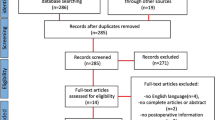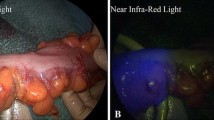Abstract
Decreased blood perfusion at the anastomotic site increases the risk of anastomotic leakage (AL) following colorectal surgery. Indocyanine green near-infrared fluoroangiography (NIRF/ICG) is a technique that allows for the assessment of intestinal perfusion before and after the formation of an anastomosis. We aimed to compare the rate of AL after colorectal surgery conducted with NIRF/ICG assessing vascular anastomotic perfusion and without this support. The data of patients who underwent colorectal surgery from November 2014 to February 2019 were reviewed retrospectively. Left-sided hemicolectomy, sigmoid resection, and anterior rectal resection were included. Emergency resections were excluded. Procedures conducted with NIRF/ICG and without NIRF/ICG (no-NIRF/ICG) support were compared using Fisher’s and Mann–Whitney U test. Overall, 196 procedures were included, 98 were carried out with no-NIRF/ICG and 98 with NIRF/ICG. Patients’ clinical and intraoperative characteristics were similar in the two groups. In the NIRF/ICG, fluorescence was detected in 100% of the cases; following NIRF/ICG the planned site of transection was changed in eight cases, whereas in one case the anastomosis was re-performed. Overall, six patients (3%) developed an AL, 0% in the NIRF/ICG and 6% (n = 6) in the no-NIRF/ICG group (p = 0.029). Median hospital length of stay was shorter in the NIRF/ICG group [6 days (IQR 6–7) vs. 7 days (IQR 6–9), p < 0.001]. The results of this study suggest that the use of the NIRF/ICG was safe for colorectal surgery and decreases the risk of anastomotic leak. A randomized trial is required to confirm these preliminary data.


Similar content being viewed by others
References
Mirnezami A, Mirnezami R, Chandrakumaran K, Sasapu K, Sagar P, Finan P (2011) Increased local recurrence and reduced survival from colorectal cancer following anastomotic leak. Ann Surg 253:890–899
McDermott FD, Heeney A, Kelly ME, Steele RJ, Carlson GL, Winter DC (2015) Systematic review of preoperative, intraoperative and postoperative risk factors for colorectal anastomotic leaks. Br J Surg 102:462–479
Kirchhoff P, Clavien P-A, Hahnloser D (2010) Complications in colorectal surgery: risk factors and preventive strategies. Patient Saf Surg 4:5
McArdle CS, McMillan DC, Hole DJ (2005) Impact of anastomotic leakage on long-term survival of patients undergoing curative resection for colorectal cancer. Br J Surg 92:1150–1154
Hammond J, Lim S, Wan Y, Gao X, Patkar A (2014) The burden of gastrointestinal anastomotic leaks: an evaluation of clinical and economic outcomes. J Gastrointest Surg 18:1176–1185
Nachiappan S, Askari A, Malietzis G, Giacometti M, White I, Jenkins JT et al (2015) The impact of anastomotic leak and its treatment on cancer recurrence and survival following elective colorectal cancer resection. World J Surg 39:1052–1058
Khoury W, Lavery IC, Kiran RP (2012) Impact of early reoperation after resection for colorectal cancer on long-term oncological outcomes. Color Dis 14:e117–e123
Kartheuser AH, Leonard DF, Penninckx F, Paterson HM, Brandt D, Remue C et al (2013) Waist circumference and waist/hip ratio are better predictive risk factors for mortality and morbidity after colorectal surgery than body mass index and body surface area. Ann Surg 258:722–730
Watanabe J, Tatsumi K, Ota M, Suwa Y, Suzuki S, Watanabe A et al (2014) The impact of visceral obesity on surgical outcomes of laparoscopic surgery for colon cancer. Int J Colorectal Dis 29:343–351
Park JS, Choi G-S, Kim SH, Kim HR, Kim NK, Lee KY et al (2013) Multicenter analysis of risk factors for anastomotic leakage after laparoscopic rectal cancer excision. Ann Surg 257:665–671
Marijnen CAM (2002) Acute side effects and complications after short-term preoperative radiotherapy combined with total mesorectal excision in primary rectal cancer: report of a multicenter randomized trial. J Clin Oncol 20:817–825
Boyle N, Manifold D, Jordan M, Mason R (2000) Intraoperative assessment of colonic perfusion using scanning laser doppler flowmetry during colonic resection 11 no competing interests declared. J Am Coll Surg 191:504–510
Kudszus S, Roesel C, Schachtrupp A, Höer JJ (2010) Intraoperative laser fluorescence angiography in colorectal surgery: a noninvasive analysis to reduce the rate of anastomotic leakage. Langenbecks Arch Surg 395:1025–1030
Boni L, Fingerhut A, Marzorati A, Rausei S, Dionigi G, Cassinotti E (2017) Indocyanine green fluorescence angiography during laparoscopic low anterior resection: results of a case-matched study. Surg Endosc 31:1836–1840
Jafari MD, Lee KH, Halabi WJ, Mills SD, Carmichael JC, Stamos MJ et al (2013) The use of indocyanine green fluorescence to assess anastomotic perfusion during robotic assisted laparoscopic rectal surgery. Surg Endosc 27:3003–3008
Jafari MD, Wexner SD, Martz JE, McLemore EC, Margolin DA, Sherwinter DA et al (2015) Perfusion assessment in laparoscopic left-sided/anterior resection (PILLAR II): a multi-institutional study. J Am Coll Surg 220(82–92):e1
Burnier P, Niddam J, Bosc R, Hersant B, Meningaud J-P (2017) Indocyanine green applications in plastic surgery: a review of the literature. J Plast Reconstr Aesthet Surg 70:814–827
Pahl FH, de Oliveira MF, Brock RS, Lucio JED (2015) Application of indocyanine green video angiography in surgical treatment of intracranial aneurysms. Arq Neuropsiquiatr 73:607–610
van Grieken NCT, van der Pas MHGM, Silvis R, Ankersmit M, Meijerink WJHJ, Bril H et al (2013) Laparoscopic sentinel lymph node identification in patients with colon carcinoma using a near-infrared dye: description of a new technique and feasibility study. J Laparoendosc Adv Surg Tech 23:367–371
Ris F, Hompes R, Cunningham C, Lindsey I, Guy R, Jones O et al (2014) Near-infrared (NIR) perfusion angiography in minimally invasive colorectal surgery. Surg Endosc 28:2221–2226
Ito M, Hasegawa H, Tsukada Y (2017) Indocyanine green fluorescence angiography during laparoscopic rectal surgery. Ann Laparosc Endosc Surg 2:7–7
Boni L, David G, Mangano A, Dionigi G, Rausei S, Spampatti S et al (2015) Clinical applications of indocyanine green (ICG) enhanced fluorescence in laparoscopic surgery. Surg Endosc 29:2046–2055
Boni L, David G, Dionigi G, Rausei S, Cassinotti E, Fingerhut A (2016) Indocyanine green-enhanced fluorescence to assess bowel perfusion during laparoscopic colorectal resection. Surg Endosc 30:2736–2742
Bosma E, Pullens MJJ, de Vries J, Roukema JA (2016) The impact of complications on quality of life following colorectal surgery: a prospective cohort study to evaluate the Clavien–Dindo classification system. Color Dis 18:594–602
Merki-Künzli C, Kerstan-Huber M, Switalla D, Gisi D, Raptis DA, Greco N et al (2017) Assessing the value of prehabilitation in patients undergoing colorectal surgery according to the enhanced recovery after surgery (ERAS) pathway for the improvement of postoperative outcomes: protocol for a randomized controlled trial. JMIR Res Protoc 6:e199
Rahbari NN, Weitz J, Hohenberger W, Heald RJ, Moran B, Ulrich A et al (2010) Definition and grading of anastomotic leakage following anterior resection of the rectum: a proposal by the International Study Group of Rectal Cancer. Surgery 147(3):339–351
Bosman F, Carneiro F, Hruban R, Theise N (2010) WHO classification of tumors of digestive system. WHO Press, Geneva, p 304e13
Weiser MR (2018) AJCC 8th edition: colorectal cancer. Ann Surg Oncol 25(6):1454–1455
Bertelsen CA, Andreasen AH, Jørgensen T, Harling H, Danish Colorectal Cancer Group (2009) Anastomotic leakage after curative anterior resection for rectal cancer: short and long term outcome. Color Dis 12(7 Online):e76–e81
Blanco-Colino R, Espin-Basany E (2018) Intraoperative use of ICG fluorescence imaging to reduce the risk of anastomotic leakage in colorectal surgery: a systematic review and meta-analysis. Tech Coloproctol 22:15–23
Kin C, Vo H, Welton L, Welton M (2015) Equivocal effect of intraoperative fluorescence angiography on colorectal anastomotic leaks. Dis Colon Rectum 58:582–587
Parsons HM (2006) What Happened at Hawthorne? New evidence suggests the Hawthorne effect resulted from operant reinforcement contingencies. Science 183(4128):922–932
De Amici D, Klersy C, Ramajoli F, Brustia L, Politi P (2000) Impact of the hawthorne effect in a longitudinal clinical study. Control Clin Trials 21:103–114
Acknowledgements
The authors thank Dr. Caitlin McIntyre for the English language revision of the manuscript.
Author information
Authors and Affiliations
Corresponding author
Ethics declarations
Conflict of interest
The authors declare that they have no competing interests.
Ethical approval
The study was carried out under ethical recommendations stated in the Helsinki Declaration. The Ethics Committee for Clinical Trials of Verona and Rovigo approved the study protocol (protocol: COLONFLUO/1500CESC).
Informed consent
Informed consent was obtained for patients undergoing NIRF/ICG procedure, whereas for patients undergoing no-NIRF/ICG the need to obtaining informed consent was waived.
Additional information
Publisher's Note
Springer Nature remains neutral with regard to jurisdictional claims in published maps and institutional affiliations.
Rights and permissions
About this article
Cite this article
Impellizzeri, H.G., Pulvirenti, A., Inama, M. et al. Near-infrared fluorescence angiography for colorectal surgery is associated with a reduction of anastomotic leak rate. Updates Surg 72, 991–998 (2020). https://doi.org/10.1007/s13304-020-00758-x
Received:
Accepted:
Published:
Issue Date:
DOI: https://doi.org/10.1007/s13304-020-00758-x




